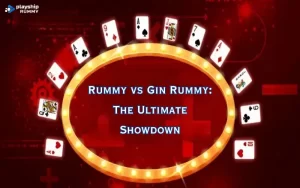Card games have been a source of entertainment for centuries, playship rummy and among the most popular are Rummy vs Gin Rummy. Both games share similarities but also have distinct differences that set them apart. In this ultimate showdown, we will explore the rules, gameplay, strategies, and unique features of Rummy and Gin Rummy, helping you decide which game suits your style best.
Understanding Rummy
What is Rummy?
Rummy is a group of matching-card games that involve forming sets or runs of cards. The objective is to meld cards into valid combinations while minimizing the points left in hand when the game ends. Rummy can be played with 2 to 6 players and is known for its engaging gameplay and strategic depth.
Basic Rules of Rummy
- Deck: Rummy is typically played with a standard 52-card deck, Rummy vs Gin Rummy and some variations may include jokers.
- Setup: Each player is dealt a specific number of cards, usually 7 to 10, depending on the variation. The remaining cards form a draw pile, Rummy vs Gin Rummy with one card placed face-up to start the discard pile.
- Gameplay: Players take turns drawing a card from either the draw pile or the discard pile and then discarding one card. The goal is to form valid combinations:
- Sets: Three or four cards of the same rank (e.g., 7♠, 7♦, 7♣).
- Runs: Three or more consecutive cards of the same suit (e.g., 4♠, 5♠, 6♠).
- Winning: The game can end when a player successfully melds all their cards or when a predetermined number of rounds is completed. The player with the lowest points in hand wins.
Variations of Rummy
Rummy has numerous variations, including Indian Rummy, Oklahoma Rummy, and more. Each variation introduces unique rules and strategies, making the game versatile and appealing to a wide audience.
Understanding Gin Rummy
What is Gin Rummy?
Gin Rummy is a two-player version of Rummy that emphasizes strategy and skill. It is designed to be fast-paced and engaging, making it a favorite among card game enthusiasts.
Basic Rules of Gin Rummy
- Deck: Gin Rummy is played with a standard 52-card deck, without jokers.
- Setup: Each player is dealt 10 cards, and the remaining cards form a draw pile. One card is placed face-up to start the discard pile.
- Gameplay: Players take turns drawing a card from the pile or the discard pile and then discarding one card. The goal is to form valid combinations and “knock” when a player has 10 points or fewer in unmatched cards.
- Winning: A player can end the round by knocking or going “gin” (melding all cards without any unmatched cards). Points are scored based on the unmatched cards in the opponent’s hand.
Scoring in Gin Rummy
In Gin Rummy, players score points based on the unmatched cards left in their opponent’s hand. The game is typically played over several rounds, Rummy vs Gin Rummy and the first player to reach a predetermined score (often 100 points) wins the game.
Key Differences Between Rummy vs Gin Rummy
1. Number of Players
One of the most significant differences between Rummy and Gin Rummy is the number of players. Rummy can accommodate multiple players, typically ranging from 2 to 6, while Gin Rummy is specifically designed for two players. This makes Gin Rummy a more intimate and strategic game, as players can focus solely on their opponent’s moves.
2. Gameplay Mechanics
While both games involve drawing and discarding cards to form sets and runs, Rummy vs Gin Rummy the gameplay mechanics differ:
- Rummy: Players can meld cards at any time during their turn, Rummy vs Gin Rummy and the game can continue until one player goes out or a predetermined number of rounds is completed. This allows for more flexibility in strategy and decision-making.
- Gin Rummy: Players must wait until they have 10 points or fewer in unmatched cards to knock. This adds an extra layer of strategy, Rummy vs Gin Rummy as players must carefully manage their hands and decide when to end the round.
3. Objective and Winning Conditions
The objectives in Rummy and Gin Rummy are similar but have distinct nuances:
- Rummy: The primary goal is to meld all cards and minimize points left in hand. Players can go out at any time, Rummy vs Gin Rummy making it essential to keep track of opponents’ moves and potential melds.
- Gin Rummy: The objective is to form valid combinations and knock when the player has 10 points or fewer in unmatched cards. Going “gin” (melding all cards) is the ultimate goal, as it earns the player a bonus.
4. Scoring Systems
The scoring systems in Rummy and Gin Rummy also differ significantly. In Rummy, players typically score based on the points of the cards left in their hands at the end of the game, Rummy vs Gin Rummy with face cards carrying higher values. In contrast, Gin Rummy has a more structured scoring system where players earn points based on the unmatched cards in their opponent’s hand after a knock or going gin. This difference in scoring can influence strategies, as players in Gin Rummy may aim to keep track of their opponent’s potential melds more closely.
Strategies for Success
Rummy Strategies
- Observe Opponents: Pay attention to the cards your opponents are picking and discarding. This can give you insights into their potential melds and help you make strategic decisions about which cards to keep or discard.
- Meld Early: If you have a strong hand, Rummy vs Gin Rummy consider melding early to reduce the points left in your hand. This can put pressure on your opponents and force them to play defensively.
- Use Jokers Wisely: If playing a variation that includes jokers, Rummy vs Gin Rummy use them strategically to complete sets or runs, but be cautious not to rely on them too heavily.
Gin Rummy Strategies
- Knock at the Right Time: Timing your knock is crucial. Wait until you have a strong hand with minimal unmatched cards, but be aware of your opponent’s potential to go gin.
- Discard Wisely: Be strategic about which cards you discard. Avoid discarding cards that could help your opponent complete their melds.
- Keep Track of Points: Always be aware of the points in your hand and your opponent’s hand. This will help you make informed decisions about when to knock or continue drawing cards.
Conclusion
In the ultimate showdown between Rummy and Gin Rummy, both games offer unique experiences and challenges. Rummy is versatile, accommodating multiple players and various styles of play, while Gin Rummy provides a focused, strategic environment for two players. Understanding the rules, gameplay mechanics, and strategies of each game can enhance your enjoyment and improve your skills.
Whether you prefer the social aspect of Rummy or the intense competition of Gin Rummy, both games are sure to provide hours of entertainment. So gather your friends or challenge a partner, and dive into the exciting world of card games. With practice and strategy, you can master both Rummy and Gin Rummy, making you a formidable opponent in any card game setting.











